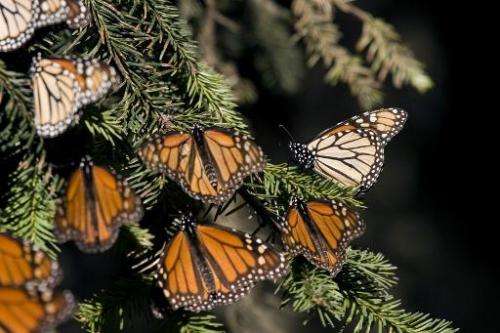Monarch butterflies plummet 90 percent, need protection

Monarch butterflies are dying off fast, with 90 percent gone in the last 20 years, and they urgently need endangered species protection, a coalition of environmental and health groups said Tuesday.
The cause of their decline is the rapid loss of milkweed, the plant on which they feed and breed, largely due to due to herbicide spraying on genetically engineered corn and soybeans on Midwestern US farmland, they said in a petition to the US Fish and Wildlife Service.
Parasites, climate change and loss of natural habitat areas are also leading factors in the plummeting numbers of the black and orange butterflies.
"Monarchs are in a deadly free fall and the threats they face are now so large in scale that Endangered Species Act protection is needed sooner rather than later, while there is still time to reverse the severe decline in the heart of their range," said Lincoln Brower, monarch researcher and conservationist.
Monarch butterflies are found throughout the United States, as well as some parts of Canada and Mexico.
The petition said that in the past two decades, they have lost more than 165 million acres of habitat—an area about the size of Texas—and that includes nearly a third of their summer breeding grounds.
"Listing will make it illegal to intentionally kill monarchs or modify their habitat without a permit," said a statement from the Center for Biological Diversity and the Center for Food Safety.
"Listing will also lead to designation and protection of 'critical habitat' to help recover abundant monarch populations."
The exact number of monarch butterflies is unknown, and their populations fluctuate from year to year, the groups said.
"But anecdotal evidence suggests that monarchs were quite abundant in the 19th century. An 1850s observer of the monarch migration in the Mississippi Valley reported so many monarchs that clouds of them darkened the sky," their statement said.
"An early account in California described tree branches breaking under the weight of so many gathered monarchs."
Studies over the past two decades suggest a "steep and statistically significant decline of nearly 90 percent," they said.
The next step is for the US Fish and Wildlife Service to issue a "90-day finding" on the petition to see if it contains enough information to show federal protection is warranted.
If so, the FWS would then undertake a one-year status review to gather additional information on whether the monarch should be added to the list of threatened species.
© 2014 AFP
















